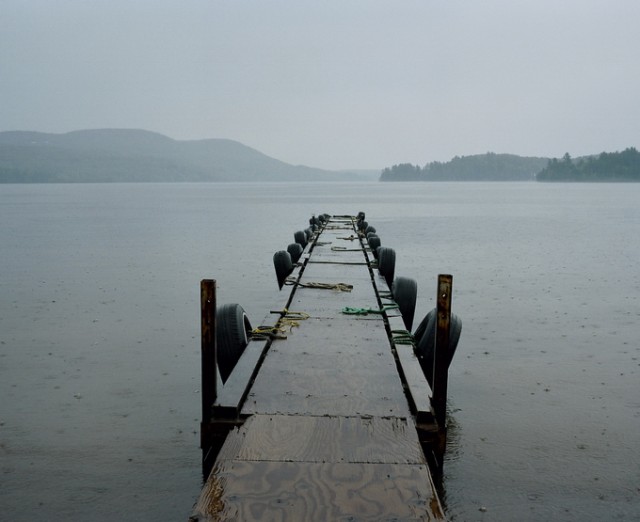If DirectTV's Ads Were Too Silly to Believe, Then Why Run Them?
Posted in: UncategorizedHere’s what I don’t get: Why did DirecTV think that Rob Lowe’s claims for the TV satellite delivery service wouldn’t be taken seriously because his alter egos such as “Painfully Awkward” and “Peaked in High School” Rob Lowe were pathetic buffoons?
And if DirecTV really thought that nobody would believe Rob Lowe’s claims, why did the company bother to make them?
Mr. Lowe’s assertions that DirecTV was “the undisputed leader in sports” and is “No. 1 in customer satisfaction” were challenged by rival TV provider Comcast, which asked the National Advertising Division of the Council of Better Business Bureaus to rule on the matter. NAD’s decision supported Comcast in most instances, but DirecTV in its defense said that the company “continues to believe that the various Rob Lowe advertisements are so outlandish and exaggerated that no reasonable consumer would believe that the statements being made by the alter ego characters are comparative or need to be substantiated.”
Hollywood Hills Residence with Two Levels of Pools
Posted in: UncategorizedL’architecte américain William Hefner a imaginé un projet architectural d’une résidence perchée sur les montagnes d’Hollywood. Il a également pensé à une terrasse luxueuse avec des piscines sur deux étages qui s’intègrent parfaitement au paysage. A découvrir en images dans la galerie.
Volkswagen Rear View: Portraits
Posted in: Uncategorized
Print
Volkswagen
No need to look bacl.
Advertising Agency:DDB, Barcelona, Spain
Creative Directors:Javier Melendez, Pedro Andragnes, Paco Cabrera
Art Director:Isabel Espona
Copywriter:Sara Lopez
Photographer:Begoña Solís.
Postproduction:Joan Gamper, Kim Boix
Account Director:Javier Villalba
Business Director:Gorka Lozano
Producer:Brigitte Villalonga
Chief Creative Officer:José María Roca de Vinyals
Pasto: Go anywhere
Posted in: Uncategorized
Print
Pasto
Advertising Agency:Freestyle, Buenos Aires, Argentina
Executive Creative Director:Diego Castillo
Creative Directors:Cristobal Oviedo, Juan Rezzonico
Head Of Art:Cristobal Oviedo
Art Directors:Felipe Ponce de Leon, Hans González, Giovana Fazio
Copywriters:Nicolás Carámbula, Alan Morer, Daniel Saavedra, Antonio Caniza, Antonio Ojeda
Planning:Edwin Rager Pérez-García Pinto
Account Director:Mauro Suarez
Manager:Facundo Moralez
Photographer:Cristobal Oviedo
Retoucher:Cristobal Oviedo
Studio:MU Realizaciones
Netflix Better Call Saul: The vicious campaign
Posted in: Uncategorized
Media, Outdoor
Netflix
Advertising Agency:Ogilvy & Mather, Paris, France
Executive Creative Director:Baptiste Clinet
Creative Director:Nicolas Lautier
Copywriter:Antoine Gauquelin, Andrew Jolliffe
Art Director:Bruno Bicalho Carvalhaes
Ceo:Philip Heimann
Business Director:Anne-Sophie Carbo
Account Supervisor:Laure Bathol
Account Executive:Alexis Valero
Jr Account Executive:Joo-Hyung Lee, Lise Gros
Strategic Planner:Amélie Delacour
Integrated Producer:Antoine Bagot
Print Producer:Fabienne Eymar
Head of Music and Sound:Virgile Stein
Production Companies:Obiwan
Managing Partner:Claude Mesquida
Hip Hop Albums in Google Street View
Posted in: UncategorizedAvec pour même concept que le travail d’Halley Docherty, le site Mass Appeal a récemment présenté cette série où des google streetviews nous montrent les lieux photographiés et figurant sur de célèbres pochettes d’albums Hip-Hop. La série nous emmène ainsi découvrir des rues et des bâtiments iconiques dans plusieurs quartiers de Los Angeles, New-York et Philadelphie.
Atmospheric Photography by Alexi Hobbs
Posted in: UncategorizedAlexi Hobbs est un photographe qui vit et travaille à Montréal. Au cours de ses voyages, l’artiste capture, grâce un sens accru de la lumière, de magnifiques clichés dont l’atmosphère est souvent proche de l’esthétique du documentaire. Plus de détails en images dans la suite de l’article.
Concept Car Splits Into Two Motorcycles
Posted in: UncategorizedArgo Design s’est associé avec la magazine Fast Company et Mark Wilson pour créer un concept de voiture à partir de deux motos. Intitulé Lane Splitter, le véhicule peut facilement se diviser en deux pour laisser place à deux motos totalement indépendantes. Plus de détails en images dans la suite.
Pasto: Bike
Posted in: Uncategorized
Go anywhere.
Advertising Agency: Freestyle, Buenos Aires, Argentina
Executive Creative Director: Diego Castillo
Creative Directors: Cristóbal Oviedo, Juan Rezzónico
Head of Art: Cristóbal Oviedo
Art Directors: Felipe Ponce de León, Hans González, Giovana Fazio
Copywriters: Nicolás Carámbula, Alan Morer, Daniel Saavedra, Antonio Caniza, Antonio Ojeda
Planning: Edwin Rager Pérez-García Pinto
Account Director: Mauro Suárez
Manager: Facundo Moralez
Photographer: Cristóbal Oviedo
Retoucher: Cristóbal Oviedo
Agency Producer: Sabrina Graña
Studio: MU Realizaciones
Published: April 2015
Pasto: Picnic
Posted in: Uncategorized
Go anywhere.
Advertising Agency: Freestyle, Buenos Aires, Argentina
Executive Creative Director: Diego Castillo
Creative Directors: Cristóbal Oviedo, Juan Rezzónico
Head of Art: Cristóbal Oviedo
Art Directors: Felipe Ponce de León, Hans González, Giovana Fazio
Copywriters: Nicolás Carámbula, Alan Morer, Daniel Saavedra, Antonio Caniza, Antonio Ojeda
Planning: Edwin Rager Pérez-García Pinto
Account Director: Mauro Suárez
Manager: Facundo Moralez
Photographer: Cristóbal Oviedo
Retoucher: Cristóbal Oviedo
Agency Producer: Sabrina Graña
Studio: MU Realizaciones
Published: April 2015
Pasto: Lagoon
Posted in: Uncategorized
Go anywhere.
Advertising Agency: Freestyle, Buenos Aires, Argentina
Executive Creative Director: Diego Castillo
Creative Directors: Cristóbal Oviedo, Juan Rezzónico
Head of Art: Cristóbal Oviedo
Art Directors: Felipe Ponce de León, Hans González, Giovana Fazio
Copywriters: Nicolás Carámbula, Alan Morer, Daniel Saavedra, Antonio Caniza, Antonio Ojeda
Planning: Edwin Rager Pérez-García Pinto
Account Director: Mauro Suárez
Manager: Facundo Moralez
Photographer: Cristóbal Oviedo
Retoucher: Cristóbal Oviedo
Agency Producer: Sabrina Graña
Studio: MU Realizaciones
Published: April 2015
Resistance
Posted in: UncategorizedDo the ends justify the means?
by
From Adbusters #119: Manifesto For World Revolution Part 2

Between 30 November and 11 December 2015, the United Nations Climate Change Conference will be held in Paris, France. Commonly known as COP 21, the goal is a legally binding agreement by all the nations of the world to reduce and adapt to anthropogenic (human-caused) climate disruption. Given decades of inaction and mounting scientific evidence that global warming is threatening human societies and promising massive species extinctions, the stakes could not be higher. Time for effective action is fast running out.
Since the best predictor of future behavior is past behavior, there is little reason for optimism. Every major meeting that was supposed to produce concrete results has failed. The politicians, oligarchs and corporate elites who are the key decision makers at these meetings pursue economic and national interests antithetical to the well being of most earthlings, human and not. Unfortunately, environmental and social justice activists, who have sought to pressure these elites, have been ineffectual. What may already be too little, too late, will certainly be too little, too late, if the tide does not turn quickly.
But how?
Has the time come for a massive wave of direct action resistance, one similar but more widespread than that sparked by Earth First!, the first avowedly “radical” environmental group?
The radical environmental movement, which first emerged in the United States in 1980, controversially transformed environmental politics by engaging in and promoting civil disobedience and sabotage as environmentalist tactics. By the late 1980s and into the 1990s, when the most militant radical environmentalists adopted the Earth Liberation Front name, arson was increasingly deployed. The targets included gas-guzzling sport utility vehicles, U.S. Forest Service and timber company offices, resorts and commercial developments expanding into wildlife habitat and universities and corporations engaged in research creating genetically modified organisms. Examples of such militant environmentalism can be found throughout the world, and they are increasingly fused with anarchist ideologies, which grow wherever there is a perception that governments, even supposedly democratic ones, do not work for everyone’s well being but for a select few. Increasingly, activists consider whether direct action resistance is necessary, and some even contend that the time has come for insurrection.
Many of those attending the Earth at Risk: Building a Resistance Movement to Save the Planet conference in Berkeley, California in November 2011, apparently thought so. Some 500 people attended this conference, which called for a new “deep green resistance” movement in response to intensifying environmental decline and increasing social inequality. The format of the conference was a scripted dialogue, or what might be called political performance art, with the writer and activist Derrick Jensen posing questions to a series of environmental activists and writers, including, most prominently, the activist and award-winning Indian author Arundhati Roy.
The tone of the meeting was sober and its messages radical. Succinctly put, the speakers issued the following diagnoses: Electoral politics and lobbying, as well as educational and other reformist conversion strategies that give priority to increasing awareness and changing consciousness, have been ineffective. Such strategies do not work because for 10,000 years agricultures have been established and maintained by violence. This violence has foremost targeted foraging societies (and later indigenous and poor people), nonhuman organisms, and nature itself. Fossil-fueled industrial-agricultural civilizations are especially destructive and unsustainable. Democratic movements have been overwhelmed by the increasingly sophisticated ways that elites justify and enforce their rule, promote materialism and the domination of nature.
In concert, the conference speakers offered radical prescriptions. They called for direct and aggressive resistance to plutocracy and environmental destruction. The immediate objective, several of them contended, should be to bring down industrial civilization—which, they claimed, has structural vulnerabilities. Specifically, they urged those gathered to form or support secret cells that would, as their first priority, sabotage the energy infrastructure of today’s dominant and destructive social and economic systems. It is also critical, they contended, that activists avoid pacifist ideologies and even carefully consider whether, and when, the time might be ripe to take up arms to overturn the system. After the most inflammatory of these statements, at least a third of the crowd rose in standing ovation.
It is not necessary to hold an anarchist or anti-civilization ideology, however, to wonder if electoral politics, lobbying and educational efforts, or litigation-based strategies are enough. Indeed, one reason that many mainstream activists sympathize with these radicals is that they often share a despairing view, given their failure spur decisive action by nations and communities in response to climate disruption.
Is it time, then, for resistance? Has it been effective or counterproductive? If effective or potentially so, which kinds are, under what circumstances, and by whom? What should be the posture of mainstream environmental organizations toward those who engage in it? It is clearly time to break the taboo against talking about resistance, and to consider what lessons can be drawn from decades of experimentation with direct action resistance.
Premises
This is ethically fraught terrain. To be as clear as possible I shall begin with a forthright statement of the premises underlying my subsequent analysis.
First, sometimes it is permissible or even obligatory to resist even legally constituted laws and policies. This statement is uncontroversial when it comes to long settled social conflicts. In hindsight at least, nearly everyone would agree that the Confessing Church’s resistance to the duly elected Nazi regime and its laws, was not only morally permissible but obligatory. To this a host of additional examples could easily be added, such that Mohandas Gandhi was justified in leading the resistance to British imperial rule, as was Martin Luther King Jr. in his often illegal pursuit of full citizenship for African Americans, and even Nelson Mandala and the African National Congress’s insurrectionary strategy to topple South Africa’s Apartheid regime.
Once it is acknowledged that laws and policies have been and can be unjust, whether to resist becomes a muddier moral terrain. When laws are enacted through democratic processes, of course, they are generally considered on first appearance to be legitimate, so any decision to break them ought not be taken lightly. Such a decision often requires someone to choose between competing goods, between moral principles that ordinarily would not be in conflict but that can be in specific cases. The best laws try to anticipate exceptions and complexity, including by fashioning penalties that recognize moral ambiguity and unusual circumstances. Breaking into someone’s home, for example, is normally and properly judged illegal, but in the case of a fire, it becomes permissible so that lives can be saved.
Criminal codes at their best carefully consider the intent of the accused, and penalties increase according to a crime’s maliciousness. But exigent circumstances are not usually factored into criminal statutes. Nor do lawmakers always anticipate and incorporate into law, as they should, new circumstances or understandings. It is not uncommon, therefore, that deeply ethical and well informed people will decide that some laws are inadequate, outdated, or just plain wrong, that the processes for changing them are too corrupt or the time too short, and that the stakes just too high to justify obedience to them.
Second, it is wrong for one species to dramatically reduce Earth’s biological diversity, and preventing anthropogenic species extinctions should be a high moral priority. This ethical premise has been defended on many grounds, a survey of which is not possible here, but they include prudential and anthropocentric concern for human welfare, biocentric philosophy or spirituality and diverse religious grounds in which protecting species is a religious duty.
Third, the best available consensus science indicates that our species is precipitating a rapid decline of biological diversity, and this process is accelerating due to anthropogenic climate change. It is also clear that political systems have not halted these processes.
Fourth, and finally, since species that go extinct are lost forever, the stakes are high and an exigent response is urgently needed. Political systems have utterly failed to arrest biodiversity decline, nor are they poised to respond quickly and effectively.
Given these ethical and factual premises, individuals and organizations should consider the reasons for this decline and how to overcome it. Since current laws and political activities have failed to redress the situation and appear unlikely to do so, it is incumbent to ask what strategies and tactics might be successful. Such an assessment should include determining whether strategies and tactics must be constrained by existing laws and prevailing assumptions about what constitutes acceptable political action.
Put more simply: anthropogenic environmental decline in the light of life-affirming values and political inaction demands analysis of the obstacles to effective action, including laws and mores that might constrain it. Given the urgency of the situation, extralegal tactics should be on the table, as they were in earlier causes where great moral urgency was properly felt.
This does not, however, answer the question of whether the time for resistance has come. For this, we would need to diagnose the reasons for the present predicaments, determine what resources can be acquired, the sort of resistance needed and whether a given action or campaign would be morally permissible, likely to be effective, and unlikely to be counterproductive. Venturing answers is perilous, in part, because there is so much complexity and uncertainty in the deeply entwined environmental and human socio-economic systems we seek to understand and affect. Yet the urgency of the situation requires nothing less.
Types of Resistance
Recognizing that social reality never perfectly reflects our maps of it, it is nevertheless useful to proceed with a review of the main types of resistance.
First, but not least, there are many ways that people of conscience resist current trends, including by battling ideas that consider the world to be a smorgasbord for ever-swelling human numbers and appetites and that view human beings as somehow exempt from nature’s laws. More important, there is a revolution going on with regard to understanding the human place in and responsibilities to nature. These are unfolding rapidly and globally, and while the trends have diverse tributaries and expressions, they also have common emotional and spiritual dimensions, including deep feelings of belonging and connection to nature, as well as convictions about the value of all living things. There are, put simply, many forms of cultural resistance to beliefs and practices that do not cohere with science or progressive environmental ethics. These trends are important to note if we are to avoid the disempowering influence of cynicism.
While contemplating the possibility and promise of resistance, it is also important to note that not everyone has the ability to participate in its more radical forms. Economically vulnerable populations, for example, might have few resources or opportunities to directly confront forces they understandably fear or upon whom they directly or indirectly depend. People in such situations, who have much to lose from direct confrontation with workplace authorities or rulers, sometimes engage in what might be labeled passive resistance. Such resistance generally involves noncooperation and noncompliance, such as through work slowdowns, theft, feigned ignorance and sometimes difficult-to-detect forms of sabotage. Such tactics are designed to avoid attention or detection. The focus here, however, is on whether more direct and aggressive forms of resistance are warranted.
For radical environmentalists, the answer is a resounding yes. Despite many differences among them, they generally agree that the agro-capitalist-industrial system is fundamentally destructive and inherently unsustainable, and moreover, the current situation so dire, that direct action resistance is not only warranted but obligatory. They differ sharply, however, over which strategies and tactics are ethically permitted and likely to be effective.
The earliest Earth First! activists, for example, hoped that a combination of public protest including civil disobedience, and sabotage to thwart and deter the greatest assaults on biodiversity, would increase public sympathy and demands for environmental protection. Often but not always, a connection was made between the erosion of biodiversity and cultural diversity (especially as represented in indigenous and peasant cultures), and concern for both animated the efforts. Some also articulated the political theory that creating an environmental extreme would serve as a counterweight to the extreme right in political battles, pulling the political center more toward the environmentalist pole of the right/left continuum, which is where laws and policies tend to end up. Yet others, such as the radical environmental activists who, after a number of their comrades were arrested, concluded that they could save nothing from prison, established the Greater Gila Biodiversity Project in 1989, which eventually became the Center for Biological Diversity. These activists were among the ones who pioneered tenacious litigation strategies, using existing laws and rules written by resource agencies to challenge, with great success, practices they considered destructive. This is another form of resistance, although it is seldom recognized as such.
While these early radical environmental activists maintained an apocalyptic view that modern society would collapse of its own unsustainable weight, their priority was to save what they could of the genetic and species variety of the planet before that inevitable collapse. They welcomed the envisioned collapse, believing it would halt the destruction and give the planet a chance to heal.
This stream of thought thus had both radical and reformist dimensions. The more optimistic activists thought that direct action resistance might help precipitate widespread consciousness change, preventing humans from overshooting their carrying capacity and precipitating the collapse of environmental and thus social systems. The more reformist participants resembled those from more mainstream environmental movements, who consider mass protests, accompanied by nonviolent civil disobedience and sometimes spectacular acts of protest and resistance (such as by Greenpeace), as a way to educate and transform public opinion and thus to change behaviors, laws and policies.
The revolutionary stream of these activists find hope only in actions that would accelerate the collapse of the societies they do not believe can be reformed voluntarily. These activists believe that, given the propaganda power of the elites who are most responsible for the destruction and who control political systems, more egalitarian, democratic and environmentally sustainable systems have no chance of being established until this system is demolished or falls of its own unsustainable weight.
In sum, when it comes to ecological resistance movements, there is a continuum of types, with varying diagnoses, strategies and tactics. One extreme of the continuum of activists, who grew in number soon after the founding of Earth First!, is represented by the Earth Liberation Front, green anarchism, and Deep Green Resistance. These forms can be labeled revolutionary resistance, and they boldly proclaim an intention to bring down, “by any means necessary,” an industrial system considered inherently destructive.
More moderate sectors of radical environmentalism represent a kind of revolutionary/reformist hybrid, which shares many of the critical perspectives about the roots and current drivers of environmental degradation but which draws more eclectically and pragmatically on revolutionary and reformist ideas, strategies, and tactics. These activists do not absolutely dismiss the possibility that, with the right combination of resistance and reform strategies, there could be an upwelling of public support for environmental health and social equity and therefore that a less catastrophic transition toward sustainability might yet be possible.
On the other end of this spectrum is reformist resistance, which endorses demonstrations, including extralegal tactics such as civil disobedience (which can be highly disruptive, as for example when logging roads or highways are blockaded) as well as diverse pedagogical efforts, hoping to sway public opinion and pressure public officials into changing laws and policies while also affecting whether they honestly and successfully enforce current laws and policies. More so than the previous two forms of resistance, here the goal is to force a democratic revolution or restore it where it has been subverted. And the hope is that this could create the conditions needed for dramatic action to address the most trenchant environmental and social problems.
Activists taking this approach may share the critical perspective of the more radical advocates of resistance about agriculture and industrialism, but they nevertheless take a more pragmatic approach, sometimes acknowledging that the current systems are powerful, resilient, and difficult to bring down. Or they may conclude that the threat to human beings, to other species, and to environmental systems would be too great should the current systems precipitously collapse and that therefore such an outcome should not be pursued.
Assessing Resistance
With premises about and types of resistance established, and with humility given the diverse variables in play and the difficulty in predicting the effects of different courses of action, it is possible to venture a broad assessment of resistance strategies. These views are quite properly subject to change, given changed circumstances and understandings.
The radical critique of agricultural, industrial civilization cannot be easily dismissed. It is true that as agricultural societies spread around the world, cultural diversity has dramatically eroded. Agricultures have displaced, murdered, or assimilated foraging peoples, whether through superior numbers and force, through the diseases their lifestyles brought with them, or through processes of settler colonialism. The erosion of biological diversity has gone hand-in-hand with these processes, all of which intensified with the power of the fossil-fuel-driven industrial age.
Modern societies are unduly celebratory of their achievements when they have amnesia about what has been lost and by whom. With an understanding of the tragic aspects of this history and recognition that these very processes are ongoing, it is clear that dramatic actions to halt these processes and engage in restorative justice and healing where possible are morally obligatory.
This does not mean, however, that the revolutionary prescription of the Deep Green Resistance activists—attacking the energetic infrastructure of industrial civilization—is warranted. Indeed, the claim that this could cause the collapse of industrial civilization is fanciful. Natural disasters (including those intensified or worsened by human activities) demonstrate that as long as energy is available, large-scale societies will rebuild. Even if resisters were to disrupt the system significantly, not only would the system’s rulers rebuild, recent history has shown that they would increase their power to suppress resisting sectors.
Moreover, as many radical activists have acknowledged in interviews—even those who have supported sabotage—the more an action risks or intends to hurt people, the more the media and public focus on the tactics rather than the concerns that gave rise to the actions. This means that the most radical tactics tend to be counterproductive to the goal of increasing awareness and concern in the general public.
When accessing the effectiveness of resistance, it is also important to address how effective authorities will be at preventing and repressing it. The record so far does not lead easily to enthusiasm for the most radical of the tactics deployed thus far. Authorities use tactics that are violent or can be framed as such to justify to the public at large spying, infiltration, disruption and even violence against these movements. Such repression typically succeeds in eviscerating the resistance, in part because as people are arrested and tried, some will cooperate with the prosecution in return for a reduced sentence.
More than half of those arrested did just that during what Federal authorities dubbed “operation backfire,” which led to the arrests and conviction of more than two dozen Earth Liberation Front saboteurs who had been involved in arson cases. One of the leaders, facing life in prison under post-9/11 terrorism laws, committed suicide shortly after his arrest, while several others became fugitives. The individuals convicted drew prison terms ranging from six to 22 years. The noncooperating activists, and those for whom terrorism enhancements had been added to the arson charges, drew the longest terms.
As if this were not devastating enough to the resistance, broader radical environmental campaigns that were not using such radical tactics ebbed dramatically in the wake of these arrests. This was because movement activists who were friends and allies of those arrested rallied to provide prison support, which then took their time and resources away from their campaigns. But it was also because the resistance community was divided over whether (and if so, how) to support the defendants who, to various degrees, cooperated with investigators. Given this history, it makes little sense to base strategy and tactics on such an unlikely possibility that communities of resistance will ever be able to mount a sustained campaign to bring down industrial civilization, even if that were a desirable objective.
The envisioned alternative to this objective—creating or, in the view of many activists, returning to small-scale, egalitarian, environmentally friendly lifestyles—would not be able to support the billions of people currently living on Earth, at least not at anything remotely like the levels of materialism that most people aspire to. So the most radical of the resistance prescriptions would quite naturally lead to strong and even violent counter-resistance.
These ideologies, explicitly or implicitly, make unduly optimistic assumptions about our species, including about our capacity to maintain solidarity in the face of governmental repression, as well as about the human capacity for cooperation and mutual aid. To expect such behavior to become the norm may be conceivable, and it may be exemplified by some small-scale societies, but it is not something to be expected universally, let alone during times of social stress intensified by increasing environmental scarcity.
So despite the accurate assessment about the ways agricultural and industrial societies have reduced biocultural diversity, there is little reason to think that the most radical resistance tactics would be able to precipitate or hasten the collapse of such societies. Nor is there much evidence that such tactics would contribute to more-pragmatic efforts to transform modern societies. In contrast, there is significant evidence that these sorts of tactics have been and are likely to remain counterproductive.
Spiking Awareness of Biodiversity Decline
There are, nevertheless, concrete historical examples where extralegal resistance has played a significant and even decisive role in campaigns to protect natural habitats and change government policies. Examples from diverse sites of contention around the world are documented in Ecological Resistance Movements: The Global Emergence of Radical and Popular Environmentalism. Many other studies have documented the successes and promise of such movements, as well as the failures and often-violent resistance that they face.
These dynamics were all present a few decades ago when activists aggressively, and often illegally, campaigned to halt deforestation in the forests of the Pacific Northwest and Rocky Mountains of the United States. Tree spiking, which involves putting metal or ceramic spikes in trees that are slated for logging, was among the most controversial of tactics. First used in anti-logging campaigns in Australia in the late 1970s and in Canada in 1982, radical environmentalists took up the practice with a vengeance in the United States during the 1980s and early 1990s.
Tree spiking was a tactic that, it was hoped, when combined with blockades and other forms of sabotage, would bankrupt logging companies believed to be engaged in unsustainable and species-threatening logging. Failing that, the hope was that logging would slow down when some of it became unprofitable due to the additional costs of removing the spikes.
Although there have been examples of spiking leading directly to the quiet cancellation of a timber sale or to economic distress for a small logging company, the practice did not often, in a direct way, significantly reduce deforestation. It did, however, have another important impact. In a short period of time, the controversy it precipitated contributed significantly to public awareness of deforestation and related endangered species issues. As Mike Roselle, one of Earth First!’s cofounders, later claimed that before they began spiking trees nobody had even heard of the ancient forests or the threats to them. Indeed, before these campaigns the term biodiversity was not in the public lexicon, nor was its value advanced in public discourse. It took these campaigns to bring the very idea of biodiversity and its importance out from obscure scientific enclaves and into public view.
With the occasional destruction of logging equipment, publicity stunts such as banner hangings, increasingly sophisticated blockades of logging roads and the occupation of logging equipment or trees to prevent logging, public awareness of these issues grew. So did expressions of concern (and sometimes outrage) to public officials. In several cases, the resistance gained enough strength to orchestrate large protests that included mass arrests, as when in 1996 thousands of citizens gathered in a sparsely populated area of northern California to protest logging by the Pacific Lumber Company (PALCO) in ancient redwood groves. More than a thousand people were arrested for trespassing on land owned by the timber company.
This, plus a decade of resistance to PALCO’s practices, contributed to political pressures to reduce social disruption and the loss of political support, and it led to heightened scrutiny and a citation to the company for violating the law. Eventually, a deal was worked out to sell the most biologically precious old-growth groves to the state of California. Not long afterward, the company went bankrupt and was sold to another firm that promised to protect the remaining ancient groves and manage the rest of its forestland more gently.
This was not the only case in which blockades of logging roads or tree occupations, which were sustained for months and even years, forced concessions from business or resource managers or provided time for attorneys to win injunctions or lawsuits against the logging. Not incidentally, one rationale for extralegal resistance is the often-accurate charge, as validated in the courts in responses to lawsuits, that industries or the government itself had broken environmental laws. Such facts allow those engaged in resistance to contend that they are actually displaying respect for laws by risking arrest and incarceration in their efforts to force companies and the government to obey existing statutes. And when governments and corporations see that they are being monitored, it contributes to improved compliance with environmental laws and regulations.
Sometimes resistance movements put so much pressure on government officials that major victories are won, as when the U.S. Forest Service under President Bill Clinton issued the Roadless Area Conservation Rule in 2001, which protected some 25 million hectares (more than 58 million acres) of federal forestland. Although it took more than a decade of legal battles for opponents of this rule to exhaust their legal challenges to it, this has become the law of the land. It is inconceivable that this rule would have been issued without more than a decade of very strong and often disruptive resistance to the Forest Service’s timber program. Although the rule does not do everything that activists sought, it is a significant advance for biodiversity conservation in North America.
A Time for Resistance?
People engaged in environmental causes around the world, including those who deploy resistance strategies, lose far more often than they win. But there are signs that direct action resistance is growing. Reports of desperate people resisting displacement from their lands and livelihoods for environmentally devastating projects justified under the rubrics of progress and development appear to be increasing in many regions, including in China, South America, Russia and a variety of other sites. Increasingly, those resisting are threatening or even in a few cases resorting to violence, although such movements have generally been the object of far more violence than they have ever deployed.
It is by no means certain that these movements will succeed or even survive the repression by authorities that they all too typically face. This will depend in no small measure on whether strong, international alliances are established and whether repressive acts are publicized internationally. Done in a way that minimizes or prevents reactionary counter-resistance and that does not lead to widespread public revulsion, ecological resistance has played and can continue to play a valuable and important role in environmental protection and sustainability.
Indeed, direct action resistance can bring attention to issues in a way that electoral politics and lobbying cannot. It can inspire action and apply political pressure on corporate and governmental officials. Like a rowdy audience or angry coach riding a referee, it can affect the decisions that are made and even whether officials will enforce the law. More significant in the long term is that such resistance may even contribute to shifting the center of public debate more toward the positions of environmentalists.
That mainstream environmental organizations and actors are reticent to acknowledge the positive role of resistance is understandable. After all, they work within the system and by its rules, and it would seem hypocritical to work for laws, policies and enforcement mechanisms while refusing to abide by society’s existing laws. Yet there are many examples of individuals and groups honored today for obeying the overwhelming majority of existing laws while protesting highly consequential and exceptionally harmful immoral laws. Martin Luther King, Jr., for one, claimed that disobeying unjust laws and facing the consequences for doing so actually expresses the highest regard for the importance and value of the law as an institution.
In August 2011, journalist and activist Bill McKibben and his group 350.org orchestrated a protest at the White House demanding action and leadership by the United States on climate change. The action led to 143 arrests that same day and over a thousand that month.
But how much more powerful these protests would be if there were a march on Washington comparable to those during the civil rights era and involving thousands of arrests by individuals demanding action on climate change? And how much more powerful yet if similar marches took place in Brussels, Beijing, Brasília, London, Moscow, Cairo, Pretoria and other centers of power around the planet?
Such a global groundswell of citizens demanding action may be emerging.
In September 2014, The People’s Climate March, with an estimated 300,000 souls, demanded action from the world’s nation states during a United Nations Climate Meeting in New York City. The meeting a part of the process leading up to the upcoming COP 15 meeting of world leaders in Paris in December. Over 100 of the protesters were arrested in a “Flood Wall Street” protest after the march. They sought to focus attention on the disinformation campaigns and lobbying that many corporations have engaged in to confuse the public and thwart governmental action. Meanwhile, solidarity events were held in 162 other countries, adding tens of thousands of additional voices to the chorus demanding action.
The Paris meeting is likely to precipitate the most dramatic action yet. The Campaign against Climate Change, for example, is planning to intensify the resistance, including an effort, involving Parisians and climate protestors gathering there from around the world, to bring the City of Lights to a standstill. Combined with similar actions around the world — perhaps led by student walkouts and hopefully with the support of union members, religious organizations and other members of civil society — they hope to demonstrate that business as usual cannot continue. Indeed, business as usual cannot continue when the environmental and climate systems upon which business, and indeed all earthly activity depends, catapults toward disaster.
Climate change protest could provide a unifying focus for forcing global changes toward social equity and environmental sustainability. And lest this seem fanciful, remember the many precedents where in the past, “people power” has toppled regimes. The global nature of the threat posed by climate change certainly makes it feasible that social protest and unrest could force concerted action on the part of targeted governments and businesses.
Arguably, such protests would be all the more effective if they were protracted and scrupulously nonviolent, while directly disrupting business as usual. Social disruption is often a prerequisite to concessions by political elites. Yet for such a dramatic, global movement to arise, there would need to be leadership from the most powerful environmental organizations, alliance building by them and the world’s religious communities, outreach and integration of labor and other civil society sectors, and careful planning regarding the kind of public theater that would be the most effective. If there is such concerted effort underway of the scale that is needed, however, I am unaware of it. But given how high the stakes are, and how slow the global response has been, it is long past time for the most prominent and respected environmental organizations and individuals to add another dimension to their advocacy for environmental sanity: direct action resistance.
If there are regrets in the struggle for sustainability among those who know the facts and the stakes involved, it may well be akin to the musings of Henry David Thoreau. Toward the end of his life, after noting how out-of-step he was with the conventional wisdom of his day, he commented, “If I repent of anything, it is very likely to be my good behavior. What demon possessed me that I behaved so well?” That is a timely question for us all.
TV Sports: Statcast Arrives, Offering Way to Quantify Nearly Every Move in Game
Posted in: UncategorizedBy measuring players’ on-field movements, Major League Baseball’s Statcast holds the promise of changing the way fans watch games and how teams evaluate and pay players.![]()
43 Marvelous Cooking Gadgets – From Multitasking Waffle Makers to Tutoring Frying Pans (TOPLIST)
Posted in: UncategorizedMeredith, Publisher of Magazines, Lays Off 100 as It Reorganizes
Posted in: Uncategorized6 Senators Urge Rejection of Comcast-Time Warner Cable Deal
Posted in: UncategorizedDirector of Talent Canfield Returns to GS&P
Posted in: UncategorizedToday we learned, via the old land line, that creative recruiter Zach Canfield has returned to Goodby, Silverstein & Partners for a third stint helping to manage its in-house talent.
Last October, Canfield became one of many industry talents poached by Google, hired to serve as the “Don’t Be Evil” company’s global creative recruiting lead.
After approximately six months in that role, he’s back with GS&P.
Canfield has an extensive history within the Goodby organization and rose to the position of associate partner/director of talent before leaving for Google (and leaving an impressive, newly redesigned reception area behind).
Canfield chose not to elaborate on the move this afternoon and referred us instead to GS&P’s PR department, but we’ve been unable to reach them for comment.
No word, then, on whether his return had anything to do with the introduction of Goodby’s new leadership team last month or whether working for Google is as great as Silicon Valley and that Vince Vaughan movie make it seem.











































































































